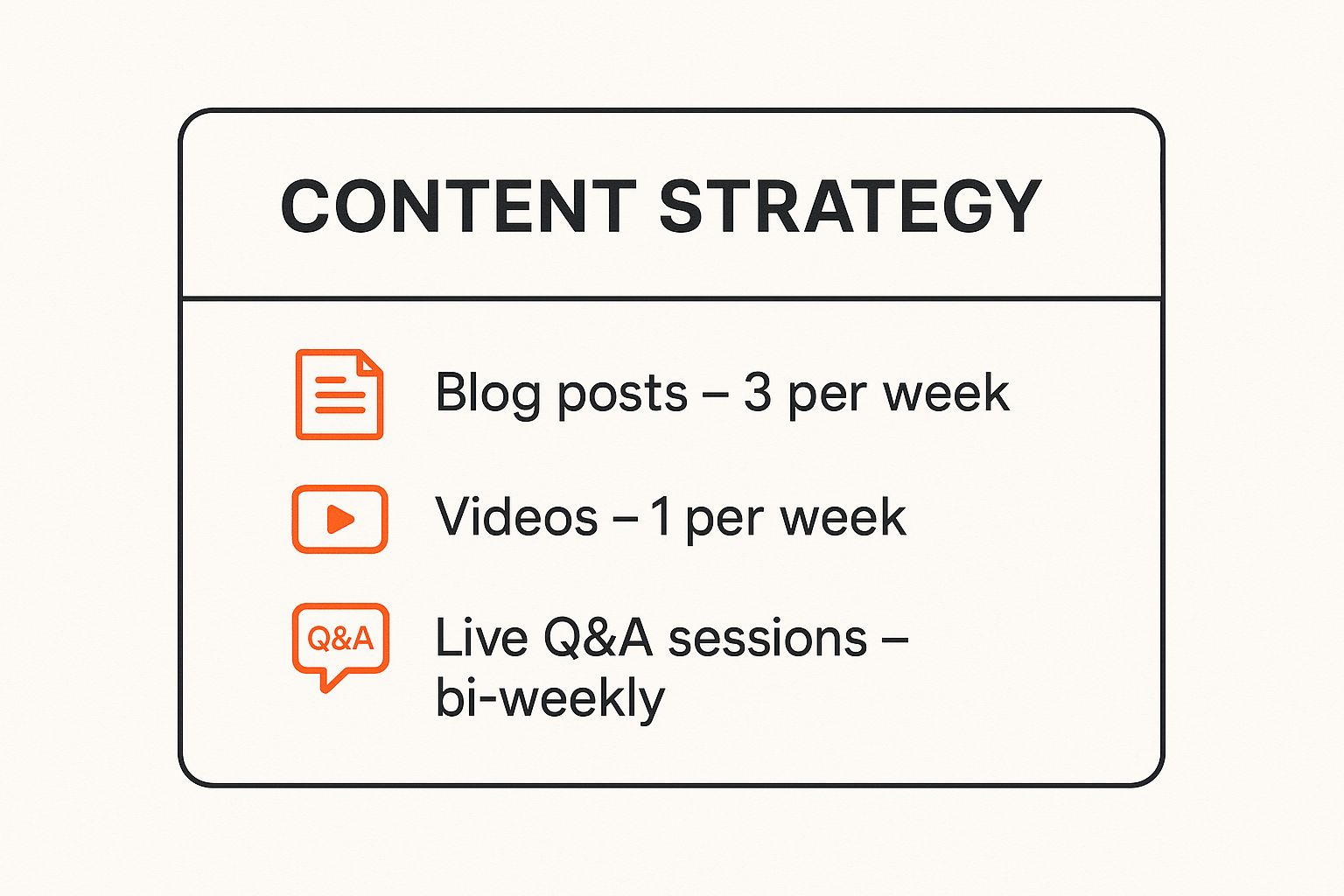Community Marketing Strategy: Drive Engagement & Results
Why Community Marketing Strategy Is Transforming Brands

Traditional marketing broadcasts messages at customers. Community marketing, on the other hand, converses with them. This fundamental shift from transactional interactions to relationship-driven engagement is transforming how brands connect with their audiences. It's also yielding a measurable business impact. Instead of simply pushing products, businesses are now focusing on fostering genuine connections and shared values. This approach recognizes that consumers today crave authentic interaction and a sense of belonging.
This transformation is driven by a growing desire for authentic connection. Consumers are increasingly seeking out brands that align with their values and offer more than just a product or service. They want to be part of something bigger – a community of like-minded individuals. For example, fitness brands are building communities around shared fitness goals. Beauty brands, meanwhile, create spaces for enthusiasts to share tips and experiences. This means brands that prioritize community building are better positioned to resonate with their target audience.
The Power of Community-Driven Engagement
The impact of community marketing is evident in its ability to boost key business metrics. Brands with active online communities see a 53% higher customer retention rate. What's more, 76% of consumers are more likely to purchase from brands that foster these strong connections. This isn't surprising, as belonging to a community naturally strengthens loyalty and encourages advocacy.
The rise of community-powered marketing has been a significant development in recent years. By 2024, the global market for community management solutions was expected to reach $4.5 billion. This growth was driven by an increased focus on customer experience and brand loyalty. It's further supported by statistics showing that 86% of businesses consider community management crucial for their success. Additionally, 72% plan to increase investment in this area by 2025. Find more detailed statistics here: Learn more about community management statistics on creatorlabz.com. This demonstrates a clear shift in how businesses view community marketing – not as a cost center, but as a strategic investment.
Positioning Community Building as a Strategic Investment
When presenting the value of community marketing to leadership, it's crucial to position community building as a strategic investment. It shouldn't be viewed as just another marketing expense. Think of it like building a house: traditional marketing is like renting a billboard – temporary and easily replaced. Community marketing, however, is like building a strong foundation – a long-term investment that yields increasing returns over time.
This long-term vision is key to securing buy-in and ensuring sustained support for community-focused initiatives. By focusing on metrics like customer lifetime value, brand advocacy, and customer acquisition cost, you can demonstrate the tangible return on investment that community marketing offers. This allows leadership to see beyond short-term costs and recognize the long-term benefits of building a thriving community.
Crafting Authenticity That Resonates With Your Audience

Authenticity is key to any successful community marketing strategy. Today's savvy consumers can quickly spot and reject manufactured authenticity. This section explores how successful brands cultivate genuine connections that resonate with their audience and stand up to scrutiny. This means understanding the nuances of genuine engagement and how it differs from superficial actions.
Humanizing Your Brand Without Losing Professionalism
Building authentic connections starts with humanizing your brand. This means stepping away from corporate jargon and engaging with your community on a more personal level. Sharing behind-the-scenes looks at your company culture or featuring employee spotlights can help your audience connect with the real people behind your brand.
However, it’s important to maintain professionalism while humanizing your brand. This requires finding a balance between being approachable and upholding a credible brand image. Responding constructively to community feedback, both positive and negative, is also essential.
Acknowledging concerns and showing a willingness to address them builds trust and strengthens your community. This open communication creates a space for genuine conversation. It also offers valuable insights for improving your products and services. This safe space encourages open dialogue and fosters a sense of belonging.
One compelling trend in community marketing strategy is the shift towards authenticity and reactive content. Brands are increasingly focusing on showcasing a human and relatable side. The Michael Cera and CeraVe partnership, for example, used Reddit lore to encourage users to explore the brand’s ownership, fostering engagement and curiosity.
This approach aligns with the growing trend of modern mythmaking, where brands tap into cultural narratives to build community and extend content lifespan. This strategy is crucial for building trust and loyalty, as consumers gravitate towards brands that interact authentically. In fact, 68.7% of consumers prefer to buy from brands they've engaged with online. Learn more about these trends: Discover more insights about community marketing trends on wearesocial.com.
Maintaining Authenticity as Your Community Scales
Maintaining authenticity becomes more complex as your community expands. However, several tactics can help preserve genuine connection as your community grows. These include:
- Developing tiered engagement models: This allows you to offer different levels of attention and personalized interaction based on community segment.
- Implementing community champion programs: Empowering enthusiastic members to become brand advocates increases your reach and fosters organic growth.
- Creating clear moderation frameworks: These guidelines maintain a positive and respectful environment while allowing for open and honest discussions.
Training your team to embody your community values is also crucial for maintaining authenticity. This ensures that every interaction reflects your brand’s genuine commitment to engagement. It also equips your team to navigate complex community situations with sensitivity and professionalism. Consistently reinforcing your values creates a culture of authenticity that resonates with your audience.
Finally, measuring the qualitative aspects of connection is vital for understanding the real impact of your strategy. While metrics like engagement and reach are important, they don’t fully capture the depth of connection you're building. Focusing on qualitative data provides valuable insights into your community’s emotional connection with your brand. This deeper understanding allows you to refine your strategy and further strengthen the bond with your audience.
Owned Communities vs. Social Media: Strategic Decision Points
The fight for audience attention is always evolving. Brands are increasingly recognizing the drawbacks of relying on social media platforms—essentially "rented land"—for their communities. This realization has led to a growing emphasis on owned communities. Let's explore why this shift is happening and the key strategic decisions involved in building a winning community marketing strategy.
Advantages of Community Sovereignty
Managing your own community space offers distinct advantages over depending solely on social media.
-
Data Ownership: Within your owned community, you have complete control over your audience data. This data offers valuable insights into member preferences, behaviors, and needs, allowing you to personalize marketing efforts and refine product development.
-
Algorithm Independence: Social media algorithms can change unexpectedly, impacting your reach. In your own space, you set the rules. This ensures consistent content visibility and facilitates direct communication with your audience.
-
Deeper Engagement: Owned communities cultivate stronger connections compared to the often superficial interactions on social media. Your brand evolves beyond a simple logo, becoming a central hub for shared values and meaningful dialogue.
Building a successful owned community, however, requires investment. This includes platform costs, community management staffing, and content creation. These resources are essential for cultivating a thriving and engaged community. This brings us to the crucial strategic decision points.
Evaluating Technology Platforms
Choosing the right platform is paramount to your community's success. The infographic below illustrates a sample content strategy you could implement:

This balanced content calendar combines informative, interactive, and engaging content, ensuring regular engagement without overwhelming your audience. When evaluating platforms, consider features like member profiles, discussion forums, event management, and integration capabilities with other marketing tools like HubSpot. For more information on creating a unified customer experience, you can refer to this resource: How to Create a Seamless Omnichannel Experience for Your Customers.
Balancing Owned and Social Presence
The optimal balance between owned communities and social media depends on your specific industry, target audience, and available resources. The evolution of community marketing has seen a shift towards owned brand communities, driven partly by concerns about losing access to followers on social media. For instance, 59.5% of marketers worry about the impact of algorithm changes.
Consequently, 27.5% of marketers already have a dedicated online brand community, and 19.5% are currently building one. This trend is further reinforced by the fact that 40.9% of consumers anticipate increased involvement in online communities in the coming year. As a result, brands are increasing investment in community management to nurture strong digital connections. Find more detailed statistics here.
While owned communities offer greater control and deeper engagement, social media platforms provide broader reach and discovery potential. A synergistic strategy often involves using social media to direct traffic to your owned community, maximizing both reach and engagement. Targeted social media ads promoting exclusive content or events within your owned community can effectively attract new members.
To illustrate the key differences, let's take a look at the following comparison:
Owned Brand Communities vs. Social Media Platforms
This table compares the key differences between building your own brand community and relying on social media platforms for community engagement.
| Feature | Owned Brand Communities | Social Media Platforms |
|---|---|---|
| Control | High (own the data and platform) | Low (subject to platform's rules and algorithms) |
| Engagement | Deep, meaningful interactions | Often superficial, driven by algorithms |
| Data Ownership | Full access and control of data | Limited data access and insights |
| Reach | Targeted, specific audience | Broad, potentially less targeted reach |
| Cost | Requires investment in platform, staffing, and content | Generally lower initial cost, but can require ad spend for reach |
This table highlights the trade-offs between the two approaches. Owned communities excel in control, engagement, and data ownership, while social media platforms offer broader reach.
Governance and Migration Strategies
Establishing clear governance structures is vital for a healthy community. This includes developing community guidelines, moderation policies, and procedures for handling disputes to ensure a positive and respectful environment.
If migrating an existing social media audience to an owned platform, a carefully planned migration strategy is essential. Clearly communicate the benefits of joining the owned community and offer incentives to encourage the switch. This minimizes the risk of member loss during the transition.
Building a strong community takes careful planning and ongoing effort. However, the benefits of community sovereignty—deeper engagement, data ownership, and algorithm independence—make it a worthwhile strategy for brands looking to cultivate lasting customer relationships.
Creating Content That Sparks Meaningful Conversations
Creating compelling content for a community requires a different approach than traditional marketing. Instead of simply broadcasting promotional messages, the focus shifts to fostering genuine conversations and building connections. This means understanding your community's needs and tailoring your content strategy to resonate with them.
Identifying Conversation Catalysts
Effective content acts as a catalyst for meaningful discussions. Just like a pebble thrown into a pond creates ripples, your content should initiate and sustain conversations within your community.
This involves finding the right balance. While promoting your products or services is important, prioritizing value-driven content is key. Think educational resources, behind-the-scenes insights, and interactive experiences. You need to find the sweet spot where your business goals align with your community's interests. This creates authentic engagement that benefits both your brand and your community members.
Actively seeking feedback is essential. Use feedback loops to shape your content strategy, ensuring it remains relevant and addresses the evolving needs of your community. For example, a clothing brand might create a style guide featuring its latest collection (promotional), but then host a community styling challenge where members share their own looks using those items (community-building). This combination of promotional and community-focused content helps create a balanced and engaging experience.
Empowering Members as Creators
Transforming community conversations into content opportunities requires empowering your members as creators. This means providing a space where they feel comfortable sharing their perspectives and experiences.
One way to do this is through user-generated content campaigns. Encourage members to create and share content related to your brand, offering incentives like featuring them on your platform or providing exclusive rewards. Another approach is to establish dedicated discussion forums. These spaces allow members to connect with each other, discuss topics of mutual interest, and foster a sense of community.
Live Q&A sessions are also valuable. These interactive formats create a direct dialogue between your brand and community members, addressing their questions and fostering a sense of shared learning. This immediate feedback provides valuable insights into community interests.
A strong community marketing strategy leverages the power of member contributions. A successful community thrives on the diverse perspectives and creativity of its members. According to the 2025 Sprout Social Index™, 93% of consumers value original content and believe brands should keep up with online culture. This highlights the importance of creating a space where members can actively participate in shaping the community narrative.
Measuring Engagement Quality
Go beyond vanity metrics like follower count and likes. Instead, focus on measuring the quality of engagement. Look at metrics that reflect the depth of interaction and the strength of connections within your community.
Here's a table summarizing effective content types for community engagement:
Effective Content Types for Community Engagement
This table presents different content formats and their effectiveness for specific community marketing objectives.
| Content Type | Best For | Engagement Level | Resource Requirements | Example Metrics |
|---|---|---|---|---|
| Blog Posts | Educating & Informing | Medium | Medium | Shares, Comments, Website Traffic |
| Videos | Showcasing Products & Storytelling | High | Medium-High | Views, Watch Time, Shares |
| Live Q&As | Direct Interaction & Feedback | High | Medium | Number of Questions, Attendee Feedback |
| User-Generated Content | Building Community & Authenticity | High | Low | Number of Submissions, Reach, Engagement |
| Discussion Forums | Fostering Conversations & Peer Support | Medium-High | Low-Medium | Active Members, Number of Threads |
This table demonstrates the diverse ways to engage a community, and how different formats require varied resources and yield different metrics. Choosing the right mix of content types is crucial for achieving your community marketing goals.
Focus on metrics that reveal the health and vitality of your community. Active members, those participating in discussions, sharing content, and attending events, are a key indicator. Average session duration, or how long members spend within your community platform, often signals deeper engagement. Sentiment analysis, analyzing the tone and emotional context of conversations, helps you understand member sentiment.
By focusing on these qualitative metrics, you can gain a deeper understanding of your community's dynamics. This allows for data-driven decisions to enhance engagement and demonstrate the value of your community to stakeholders by showcasing the strong connections you are building. This data-driven approach leads to more meaningful and impactful interactions, shaping a more effective overall community marketing strategy.
Measuring Community Impact Beyond Vanity Metrics

Demonstrating the return on investment (ROI) of your community marketing strategy requires connecting relationship-building activities to tangible business outcomes. Tracking vanity metrics like follower count and likes isn't enough. Stakeholders need to see how community building translates into increased sales, improved customer retention, and stronger brand advocacy. This means moving beyond surface-level engagement and focusing on more meaningful measurements.
Sophisticated Attribution Models
Proving community ROI relies on implementing attribution models that accurately capture the community's influence on customer behavior. Traditional models often fail to account for the indirect impact of community engagement. For instance, a customer might not purchase directly through a community platform.
However, the positive interactions and information shared within the community could still significantly influence their later purchasing decisions. Therefore, sophisticated attribution models are essential. These models help understand the full customer journey and recognize all touchpoints where the community plays a role. This involves looking beyond last-click attribution and considering multi-touch attribution models, assigning value to all interactions, including community engagement.
Measuring Community Health Indicators
Demonstrating community impact also involves measuring community health indicators. These metrics offer insights into the overall well-being and engagement levels within your community. Some key indicators include:
- Active Members: The percentage of members actively participating in discussions, sharing content, and attending events.
- Average Session Duration: The time members spend on your community platform, indicating their engagement depth.
- Sentiment Analysis: Evaluating the emotional tone of conversations to gauge overall member satisfaction.
These metrics provide a broader perspective on community health and can often predict future business impact. For example, a decline in active members or negative sentiment shifts could signal potential problems needing attention before they affect customer retention or sales.
Custom Metrics and Executive Dashboards
Developing custom metrics aligned with your specific business objectives is also key to proving community value. Consider tracking metrics such as:
- Community-Sourced Leads: Leads generated through community interactions and referrals.
- Customer Lifetime Value (CLTV) Impact: The difference in CLTV between community members and non-members.
- Brand Advocacy Score: Measuring the frequency and impact of positive mentions and recommendations from community members.
You might be interested in: 5 Ways to Drive Revenue with Customer Loyalty and Engagement.
Implement tracking systems that capture both quantitative and qualitative data. Then, create executive dashboards that communicate community impact clearly to stakeholders. These dashboards should present key metrics concisely, highlighting the link between community activities and business results. This helps stakeholders understand the value of your community marketing strategy and justify continued investment. Visualizations like charts and graphs make the data more accessible and impactful.
Scaling Your Community Strategy Without Losing Connection
As your community grows, maintaining those initial authentic connections becomes a challenge. It's like a close group of friends that feels less intimate as more people join. However, this doesn't mean genuine engagement is impossible with a larger group. By examining strategies used by thriving communities, we can learn how to maintain a sense of closeness while expanding our reach.
Tiered Engagement and Community Champions
One effective approach is creating tiered engagement models. Think of it like a gardener tending to different plants with varying levels of care. Tiered engagement provides different levels of attention and personalized interaction based on member activity. This could include exclusive content for highly engaged members, early access to new products, or even direct interaction with the team.
Community champion programs can greatly extend your team's reach. These programs empower enthusiastic members to take on leadership roles, acting as moderators, mentors, or event organizers. This approach scales your team's efforts while preserving personal connections. It's like having trusted members help guide and support the wider community.
Moderation and Community Insights
Scaling also requires strong moderation frameworks. These frameworks act as the community's guiding principles, setting boundaries and encouraging respectful dialogue. Think of it as a constitution for your community, ensuring a positive environment for open communication. Clear rules around inappropriate language or harassment, for example, help create a safe and welcoming space for all.
Integrating community insights across your organization is also key. This involves ensuring that feedback from your community informs decisions across various departments, from product development to marketing and customer service. Product feedback, for instance, can shape product roadmaps, while community discussions can inspire marketing content. Read also: How to Budget Around a Loyalty Program. This cross-functional integration ensures your community remains a valuable resource.
Resourcing and Tool Selection
Scaling successfully also demands a practical approach to resourcing and tool selection. As your community grows, so will your needs for staffing, technology, and budget. Community management software can streamline tasks, automate workflows, and provide insightful data on community activity.
Choosing the right tools can also strengthen connections. Look for platforms with features like personalized member profiles, interest-based discussion forums, and event management capabilities. These tools create opportunities for members to connect based on shared interests, fostering a sense of belonging even within a large group. This strategic approach to resources and tools ensures your platform can handle growth without sacrificing connection quality.
Successfully scaling your community requires balancing growth with genuine connection. By implementing these practical strategies, your community can remain vibrant and valuable for both your brand and your members, building a sense of shared purpose that fuels long-term success.
Ready to build a thriving and scalable community? Toki provides an all-in-one platform for cultivating customer relationships, driving repeat business, and building brand advocates. Discover how Toki can transform your community marketing strategy.